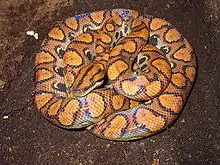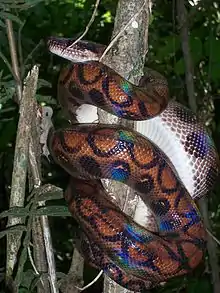Rainbow boa
Epicrates cenchria is a boa species endemic to Central and South America. Common names include the rainbow boa,[2] and slender boa. A terrestrial species, it is known for its attractive iridescent/holographic sheen caused by structural coloration. Five subspecies are currently recognized, including the nominate subspecies described here.[2] Due to one of its common names being the rainbow snake, as seen above.
| Rainbow boa | |
|---|---|
 | |
| Scientific classification | |
| Kingdom: | Animalia |
| Phylum: | Chordata |
| Class: | Reptilia |
| Order: | Squamata |
| Suborder: | Serpentes |
| Family: | Boidae |
| Genus: | Epicrates |
| Species: | E. cenchria |
| Binomial name | |
| Epicrates cenchria | |
| Synonyms[1] | |
| |
Distribution and habitat
E. cenchria is found in lower Central America (Costa Rica and Panama), and farther south into South America it occurs east of the Andes roughly reaching northern Argentina (in the provinces: Chaco, Córdoba, Corrientes, Formosa, Salta, Santiago del Estero and Tucumán).
The Rainbow Boa's habitat generally consists of humid woodlands and rain forests but they can also be found in open savannas.[3]
Captivity
Despite requiring very specific humidity and heat, this species is commonly found in the pet trade. During the 1980s and early 1990s, substantial numbers were exported from Suriname. Today, however, far fewer are exported, and most offered for sale are captive bred.[4] Due to their need for high humidity in a captive environment, they should be considered of intermediate difficulty for snake owners, but as long as that is provided they can thrive in captivity. Younger specimens will often bite because of natural defensive instincts, but tend to calm down as they become used to handling.
Subspecies
| Subspecies[2] | Taxon author[2] | Common name | Geographic range |
|---|---|---|---|
| E. c. barbouri | Stull, 1938 | Marajo Island rainbow boa | |
| E. c. cenchria | (Linnaeus, 1758) | Brazilian rainbow boa | The Brazilian rainbow boa occurs in the Amazon Basin, and in coastal Guiana, French Guyana, Suriname and southern Venezuela. |
| E. c. gaigeae | Stull, 1938 | Peruvian rainbow boa | |
| E. c. hygrophilus | Amaral, 1935 | Espirito Santo rainbow boa | |
| E. c. polylepis | Amaral, 1935 | Central highland rainbow boa | |
Etymology
The subspecific name, barbouri, is in honor of American herpetologist Thomas Barbour.[5]
The subspecific name, gaigeae, is in honor of American herpetologist Helen Beulah Thompson Gaige.[5]
Gallery
 Peruvian subspecies.
Peruvian subspecies.
References
- McDiarmid RW, Campbell JA, Touré T (1999). Snake Species of the World: A Taxonomic and Geographic Reference, Volume 1. Washington, District of Columbia: Herpetologists' League. 511 pp. ISBN 1-893777-00-6 (series). ISBN 1-893777-01-4 (volume).
- "Epicrates cenchria ". Integrated Taxonomic Information System. Retrieved 10 July 2008.
- "Brazilian Rainbow Boa". ReptileRange. Retrieved 5 May 2020.
- Brazilian Rainbow Boa at Smithsonian National Zoological Park. Accessed 12 November 2008.
- Beolens, Bo; Watkins, Michael; Grayson, Michael (2011). The Eponym Dictionary of Reptiles. Baltimore: Johns Hopkins University Press. xiii + 296 pp. ISBN 978-1-4214-0135-5. (Epicrates cenchria alvarezi, p. 6;
E. c. barbouri, p.16; E. c. gaigeae, p. 96).
External links
| Wikimedia Commons has media related to Epicrates cenchria. |
- Epicrates cenchria at the Reptarium.cz Reptile Database. Accessed 10 July 2008.
- . Collier's New Encyclopedia. 1921.
Further reading
- Boulenger GA (1893). Catalogue of the Snakes in the British Museum (Natural History). Volume I., Containing the Families ... Boidæ ... London: Trustees of the British Museum (Natural History). xiii + 448 pp. + Plates I-XXVIII. (Epicrates cenchris, pp. 94-96).
- Freiberg M (1982). Snakes of South America. Hong Kong: T.F.H. Publications. 189 pp. (Epicrates cenchria, pp. 87-88, 125-127 + photographs on pp. 18-19, 22-23, 45).
- Linnaeus C (1758). Systema naturæ per regna tria naturæ, secundum classes, ordines, genera, species, cum characteribus, dierentiis, synonymis, locis. Tomus I. Editio Decima, Reformata. Stockholm: L. Salvius. 824 pp. (Boa cenchria, new species, p. 215). (in Latin).